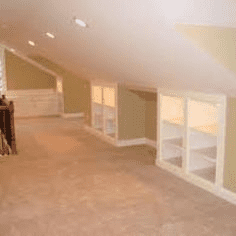What is a Knee Wall?
A knee wall is simply any wall that slants down from the ceiling to 4 ft or even to the ground. These are often found in Cape-cod, Gambrel Colonials, and Bungalow style homes.
This wall tends to report differences in your gross living area. An appraiser may measure only where the wall is greater than 7 feet tall. This often the discrepancy when it comes to reporting GLA in comparison to what is on public record. As of April 2022, Real Estate Appraisers must adhere to ANSI (American National Standard Institute) measuring guidelines for all Fannie Mae loans issued. When inspecting the subject property, real estate appraisers are looking to find the area that has a ceiling height of 5′ or more. There are some more catches to this as well.
Ceiling Height
To be included in the finished square footage calculations, finished areas must have a ceiling height of at least 7 feet except under beams, ducts and other obstructions where the height may be 6 feet 4 inches; under stairs where there is no specified height requirement; or where the ceiling is sloped. If a room’s ceiling is sloped, at least one-half of the finished square footage in that room must have a vertical ceiling height of at least 7 feet; no portion of the finished area that has a height of less than 5 feet may be included in finished square footage.
Living Area Discrepancies Between Public Records and Appraiser Values
This is generally more common for homeowners who have multi-level properties where the 2nd or 3rd floor do not match the base level. Local assessors typically do not measure upper levels of living space within residential properties. Instead they commonly approximate. An example would be that you may find your local assessor approximating the 2nd floor living space of your Cape-style property to 1/2 of the value below it. If the Cape has a full dormer, then the assessor may employ a 3/4 multiple for the living area. It gets even more rough in properties like Tudor or contemporary builds.
Often the assessor may have areas like open foyers or voids above garages, but you can never be sure unless you have it verified. This is why lenders insist appraisers measure the property. If you are a potential buyer and are not sure if the living area is accurate, check the appraisal. If one hasn’t been completed, ask the real estate agent to see if they can verify the measurements. Many marketed properties include all living area which sometimes includes basement finish. This is also an important thing to review on your property’s public record card. Appraisers stratify living area to above-grade and below grade. This may not jive with how it was marketed. If you are unsure its always best to refer to a local appraiser. They are great resources to what is most beneficial and how the living area is computed on a loan.






